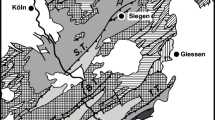Abstract
This paper presents materials on one of the units with PGE ore mineralization in the Pana Massif: the results of a detailed petrographic study and microprobe analyses of silicate and sulfide minerals and of the examination of mineral assemblages, typomorphic features of minerals, their crystallization succession and P–T conditions of this crystallization in the mineralized unit and the host mineralized and barren rocks, and the distribution of the fluid phase in them. Metamorphic processes that accompanied the development of the sulfide and PGE mineralization zones are analyzed, and it is established that the metamorphic evolution was associated with changes in the mineralogy of the rock and the composition of fluid in it. This process was of a unidirectional and systematic character and can be realistically reproduced in physicochemical models. The results of our research make it possible to assay the effect of P–T parameters and the fluid regime on the component composition of the solid phases and volatile components during the origin and localization of the PGE ore mineralization.
Similar content being viewed by others
References
H. C. Helgeson, “Evaluation of Irreversible Reactions in Geochemical Processes Involving Minerals and Aqueous Solutions. 1. Thermodynamic Relations,” Geochim. Cosmochim. Acta 32(8), 853–877 (1968).
H. C. Helgeson, R. M. Garrels, and F. T. Mc Cenzie, “Evaluation of Irreversible Reactions in Geochemical Processes Involving Minerals and Aqueous Solutions. II. Applications,” Geochim. Cosmochim. Acta 33(4), 455–481 (1969).
H. C. Helgeson, T. H. Brown, A. Nigrini, and T. A. Jones, “Calculation of Mass Transfer in Geochemical Processes Involving Aqueous Solutions,” Geochim. Cosmochim. Acta 34(5), 569–592 (1970).
I. K. Karpov, A. I. Kiselev, and F. A. Letnikov, Computer Simulation of the Formation of Minerals in Nature (Nedra, Moscow, 1976) [in Russian].
I. K. Karpov, Physicochemical Numerical Simulations in Geochemistry (Nauka, Novosibirsk, 1981) [in Russian].
S. A. Kashik and I. K. Karpov, Physicochemical Theory of the Origin of Weathering Crust Zoning (Nauka, Novosibirsk, 1978) [in Russian].
I. L. Khodakovskii, V. P. Volkov, Yu. I. Sidorov, and M. V. Borisov, “Mineralogical Composition of the Rocks. Hydration and Oxidation of the Outer Shell of Venus”, Geokhimiya, No. 12, 1821–1835 (1978).
Yu. V. Shvarov, “Calculation of an Equilibrium Composition in a Multicomponent Heterogeneous System,” Dokl. Akad. Nauk SSSR 229(5), 1224–1226 (1976).
Precambrian Magmatic Associations of the Northeastern Baltic Shield, Ed. by I. V. Bel’kova (Nauka, Leningrad, 1985) [in Russian].
F. P. Mitrofanov, Yu. N. Yakovlev, V. V. Distler, et al., “Kola Region as a New PGE-bearing Province”, in Geology and Genesis of the PGM Deposits (Nauka, Moscow, 1994), pp. 65–79 [in Russian].
A. U. Korchagin, E. M. Bakushkin, and L. A. Vinogradov, “Geological Structure of the Marginal Zone of the Pana Tundra Massif and Its PGM Mineralization”, in Geology and Genesis of the PGM Deposits (Nauka, Moscow, 1994), pp. 100–106 [in Russian].
Z. M. Voloshina, V. P. Petrov, L. I. Popova, and S. A. Rezhenova, “Metamorphic Assemblages in the Rocks of the Lower Layered Horizon of the Pana Tundra Intrusion”, Zap. Vseross. Mineral. O-va, No. 3, 57–65 (1998).
B. E. Leake, “A Catalog of Analyzed Calciferous and Subcalciferous Amphiboles Together with Their Nomenclature and Associated Minerals,” Geol. Soc. Am. Spec. Paper (1974).
R. Kretz, “Symbols for Rock-Forming Minerals”, Am. Miner. 68(1–2), 277–279 (1983).
R. G. Berman, “Thermobarometry Using Multi-Equilibrium Calculations: A New Technique, with Petrological Applications,” Can. Mineral. 29(4), 833–855 (1991).
R. G. Berman, “Internally-Consistent Thermodynamic Data for Minerals in the System Na2O-K2O-CaO-Al2O3-SiO2-TiO2-H2O-CO2,” J. Petrol. 29(2), 445–522 (1988).
V. K. Karzhavin, “Platinum Group Elements,” Vestn. OGGGN RAN 1(21), (2003); URL: http://www.scgis.ru/russian/cp1251/h_dgggms/1-2003/informbul-1_2003.html#1.1
V. K. Karzhavin, “Sulfides of Platinum and Palladium. Thermodynamic Properties,” in Proceedings of the Annual Seminar on Experimental Mineralogy, Petrology, and Geochemistry, Moscow, Russia, 2004 (ONTI GEOKhI RAS, 2004), pp. 31–33.
R. A. Lidin, V. A. Molochko, and L. L. Andreeva, Chemical Composition of Inorganic Compounds (Khimiya, Moscow, 2000) [in Russian].
V. K. Karzhavin, “Amphiboles: Thermodynamic Properties,” Geokhimiya, No. 12, 1724–1732 (1991).
Author information
Authors and Affiliations
Additional information
Original Russian Text © V.K. Karzhavin, Z.M. Voloshina, 2006, published in Geokhimiya, 2006, No. 5, pp. 522–531.
Rights and permissions
About this article
Cite this article
Karzhavin, V.K., Voloshina, Z.M. Simulation of metamorphism and fluid regime in the mineralized unit of the Pana Massif in relation to its PGE ore mineralization. Geochem. Int. 44, 475–484 (2006). https://doi.org/10.1134/S0016702906050041
Received:
Issue Date:
DOI: https://doi.org/10.1134/S0016702906050041




